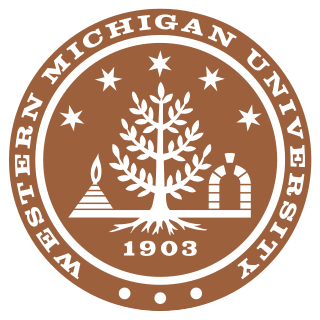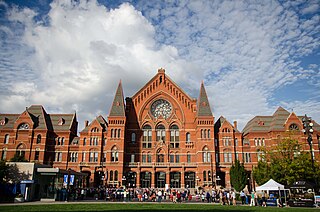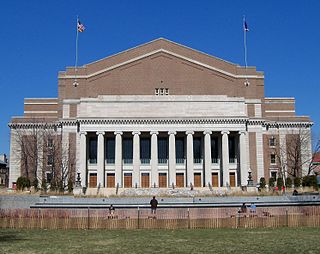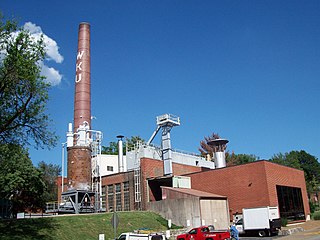
Western Michigan University is a public research university in Kalamazoo, Michigan. It was initially established as Western State Normal School in 1903 by Governor Aaron T. Bliss for the training of teachers. In 1957, G. Mennen Williams signed a bill into law that made Western a university and gave the school its current name of Western Michigan University.

The Royal Festival Hall is a 2,700-seat concert, dance and talks venue within Southbank Centre in London. It is situated on the South Bank of the River Thames, not far from Hungerford Bridge, in the London Borough of Lambeth. It is a Grade I listed building, the first post-war building to become so protected. The London Philharmonic Orchestra, the Philharmonia Orchestra, the Orchestra of the Age of Enlightenment, the London Sinfonietta, Chineke! and Aurora are resident orchestras at Southbank Centre.

The Mark Taper Forum is a 739-seat thrust stage at the Los Angeles Music Center designed by Welton Becket and Associates on the Bunker Hill section of Downtown Los Angeles. Named for real estate developer Mark Taper, the Forum, the neighboring Ahmanson Theatre and the Kirk Douglas Theatre are all operated by the Center Theatre Group.

Hill Auditorium is the largest performance venue on the University of Michigan campus, in Ann Arbor, Michigan. The auditorium was named in honor of Arthur Hill (1847-1909), who served as a regent of the university from 1901 to 1909. He bequeathed $200,000 to the university for the construction of a venue for lectures, musical performances, and other large productions. Opened in 1913, the auditorium was designed by Albert Kahn and Associates. It was renovated by the same firm beginning in 2002 and was re-opened in 2004.

Music Hall, commonly known as Cincinnati Music Hall, is a classical music performance hall in Cincinnati, Ohio, completed in 1878. It serves as the home for the Cincinnati Ballet, Cincinnati Symphony Orchestra, Cincinnati Opera, May Festival Chorus, and the Cincinnati Pops Orchestra. In January 1975, it was recognized as a National Historic Landmark by the U.S. Department of the Interior for its distinctive Venetian Gothic architecture. The building was designed with a dual purpose – to house musical activities in its central auditorium and industrial exhibitions in its side wings. It is located at 1241 Elm Street, across from the historic Washington Park in Over-the-Rhine, minutes from the center of the downtown area.

Cyrus Northrop Memorial Auditorium is a performing arts venue at the University of Minnesota in Minneapolis, Minnesota. It is named in honor of Cyrus Northrop, the university's second president. Various events are held within the building, including concerts, ballet performances, lectures, and graduations.

Heinz Hall is a performing arts center and concert hall located at 600 Penn Avenue in the Cultural District of Pittsburgh, Pennsylvania. Home to the Pittsburgh Symphony Orchestra (PSO) and the Pittsburgh Youth Symphony Orchestra, the 2,676 seat hall presents about 200 performances each year. Originally built in 1927 as Loew's Penn Theatre, the former movie palace was renovated and reopened as Heinz Hall in 1971.

The Danforth Campus is the main campus at Washington University in St. Louis. Formerly known as the Hilltop Campus, it was officially dedicated as the Danforth Campus on September 17, 2006, in honor of William H. Danforth, the 13th Chancellor of the University, the Danforth family and the Danforth Foundation. Distinguished by its collegiate gothic architecture, the 169-acre (0.68 km2) campus lies at the western boundary of Forest Park, partially in the City of St. Louis. Most of the campus is in a small enclave of unincorporated St. Louis County, while all the campus area south of Forsyth Boulevard is in suburban Clayton. Immediately to the north across Forest Park Parkway is University City.

Alumni Hall at the University of Pittsburgh is a Pittsburgh History and Landmarks Foundation Historic Landmark that was formerly known as the Masonic Temple in Pittsburgh. Constructed in 1914-1915, it was designed by renowned architect Benno Janssen of Janssen & Abbot Architects. Other buildings in Pittsburgh's Oakland Cultural District designed by Janssen include the Pittsburgh Athletic Association, Mellon Institute, and Pitt's Eberly Hall.

East Campus is a collection of buildings and facilities situated on the 60-acre (240,000 m2) hilltop campus that is the original site of Western Michigan University. It includes some of WMU's athletic facilities including Waldo Stadium, Hyames Field, Ebert Field and the Donald Seelye Athletic Center. The campus sits on the top of Prospect Hill, which overlooks the city of Kalamazoo, Michigan.

Henry Hardin Cherry Hall is a building located on the campus of Western Kentucky University in Bowling Green, Kentucky. Built with funds appropriated under the New Deal, the building was completed in 1937. It is named for Henry Hardin Cherry, who founded the Bowling Green Normal School, the forerunner of the modern university. It was added to the National Register of Historic Places in 1979.

The Western Kentucky University Heating Plant is a historic structure on the campus of Western Kentucky University. Constructed in 1927, it was added to the National Register of Historic Places on December 18, 1979.

The Foellinger Auditorium, located at 709 S. Mathews Avenue in Urbana, Illinois on the campus of the University of Illinois Urbana-Champaign, is a concert hall and the university's largest lecture hall. It is the southernmost building on the main quad. Its size and its dome make it one of the university’s most recognizable buildings. The building was completed in 1907 and was designed by Clarence H. Blackall, a noted theatre designer, in the Beaux-Arts style. The building is essentially a circle with a 120-foot diameter covering 17,000 square feet, with a large vestibule on the north side, and 396 lights in its copper dome.
The Emery Theatre, or Emery Auditorium, is a historic, acoustically exceptional theater located in the Over-the-Rhine neighborhood of Cincinnati, Ohio. The building was constructed in 1911 as the home for a trade school, but its large, impressive auditorium was intended for public use. The design of the Emery Theatre is based on the "isacoustic curve" principles that were first proposed by John Scott Russell. The theatre was built with two balconies and a total of 2,211 seats. It was one of the first concert halls in the United States to have no obstructed seats.
The James D. Westcott Building is a historic building on the campus of The Florida State University in Tallahassee, in the U.S. state of Florida. The Westcott Building currently houses the chief administrative offices for Florida State University and is the primary focal point of the campus as seen down College Avenue. The building is also home to Ruby Diamond Auditorium. It is known for its distinctive appearance.
The University of Arkansas Campus Historic District is a historic district that was listed on the National Register of Historic Places on September 23, 2009. The district covers the historic core of the University of Arkansas campus, including 25 buildings.

Pease Auditorium is a music venue on the campus of Eastern Michigan University in Ypsilanti, Michigan. Built in 1914, Pease auditorium is the 4th oldest standing building on Eastern Michigan University's campus. The auditorium was constructed in 1914 for $243,963. For the time, that was a considerable amount of money. Today Pease is home to the university's music performances and as well as some performing arts productions. With a seating capacity of 1,700, Pease is a prime spot for many events held by the community.

Brinton Beauregard Davis was an architect in Kentucky. More than a dozen of his works are listed on the National Register of Historic Places.

Richardson Auditorium in Alexander Hall is a historic 900-seat Richardsonian Romanesque performance hall at Princeton University in Princeton, New Jersey. It is home to both the Princeton University Orchestra and the Princeton Symphony Orchestra.

University College, historically known as the Arts Building, is an academic building of the University of Western Ontario on its main campus in London, Ontario. The building has become an iconic symbol of the university, as well as a prominent landmark in the city of London. The building sits atop a hill and faces the Thames River. Along with the Physics and Astronomy Building, University College is one of the first buildings that was built on the present campus in 1922. The building currently houses the Faculty of Arts and Humanities.


















